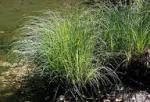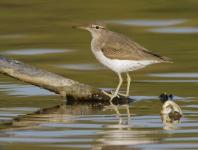Open Water
Open water aquatic habitats occur throughout the County, and are highly diverse in size, type, water chemistry, and functions. Two types of open water habitats are recognized:
- Streams
- Reservoirs
Streams throughout the County vary from narrow mountain streams to broad lowland rivers. The County contains approximately 6,650 miles of stream channels, including ephemeral washes with a bed and bank but no riparian vegetation or feeder streams.
There are seven major public reservoirs within Napa County. Lake Berryessa is by far the largest, covering over 18,000 acres (nearly 4% of the total land area of the County and approximately 60% of the open water). Other public reservoirs throughout the County include Lake Hennessey, Friesen Lakes, and Lake Curry. These reservoirs range in size from 15 to 750 acres. In addition, the County contains many smaller private reservoirs.
Few plants grow within fast-flowing streams. A few species that may be found in or adjacent to such streams include torrent sedge, giant chain fern (Woodwardia fimbriata), and bulrush (Scirpus microcarpus). Aquatic mosses and filamentous algae that are tightly attached to rocks by strong holdfasts are two groups of plants that can survive the fast current.
Deepwater aquatic habitats are too deep for emergent plants, but are inhabited by phytoplankton—tiny suspended plants. Most reservoirs lack a well-developed margin of wetland and riparian plants due to their steep-sided slopes and fluctuation son water level. However, where shallow water does occur and draw-down is slow, common aquatic and emergent plants are similar to that as described for freshwater wetlands.

Torrent sedge

Giant chain fern
(Woodwardia fimbriata)

Bulrush
(Scirpus microcarpus)
Wildlife species commonly found along streams include green heron (Butorides virescens), snowy egret, and wood duck. Invertebrates found around creeks and rivers include mayflies, alderflies, and dragonflies. Aquatic species such as frogs, salamanders and western pond turtles are found in streams during breeding and larval/juvenile stages. The Napa River provides habitat for fish species such as striped bass (Morone saxatilis), steelhead, and green sturgeon (Acipenser medirostris) to names a few. Anadromous fish runs, such as steelhead, have declined drastically, and there has been a complete loss of the coho salmon run. Fall run Chinook salmon have been documented breeding in lower Putah Creek and the Napa River.
Wildlife associated with reservoirs in the County includes breeding and wintering western grebe (Aechmophorus occidentalis), common merganser (Mergus merganser), osprey (Pandion haliaetus), bald eagles and wintering ducks and gulls. Fish species in Lake Berryessa and other reservoirs consist almost entirely of introduced species, including threadfin shad, common carp, bluegill (Lepomis macrochirus) and spotted bass (Micropterus punctatus).
Birds:

Spotted sandpiper
(Actitis macularia)

Belted kingfisher
(Ceryle alcyon)

Black phoebe
(Sayornis nigricans)
Aquatic:

Catfish
(Ictalurus and Pylodictis spp.)

Prickly sculpin
(Cottus asper)

Pacific lamprey
(Lampetra tridentata)
The primary ecosystem functions and services of streams and reservoirs in the County are:
- Maintain surface and groundwater quality through filtration and decomposition of pollutants
- Prevent flooding by storing floodwaters
- Recharge groundwater aquifers
- Service floodplain fertility by flooding and deposition of fine sediments (streams specifically)
- Provide water for human, animal, and wildlife use
- Provide wildlife habitat
- Provide opportunities for recreation including, but not limited to, fishing and boating
Use the map below to explore the various biotic communities throughout Napa County.



